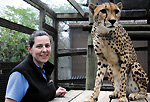A Career on the Wild Side
Open gallery

It was a chance encounter with a pileated woodpecker that sparked Linda Castaneda’s fascination with wildlife.
On her way to class as an undergraduate at Lewis & Clark, she looked up and was captivated by the great bird’s beauty. But she also felt a sense of sadness, since such diverse wildlife was never part of her inner-city home in Lynwood, California, near Los Angeles.
“I envisioned a future in which nobody got to experience wild creatures,” she says, “and I knew that, one day, I would work with wild animals.”
Castaneda went on to do field research on the nesting success of songbirds in Eastern Oregon with the U.S. Forest Service and to spend six months with the Center for Tropical Research in the jungles of Cameroon, crouched under trees and tiny leaf huts observing the feeding habits of hornbills and monkeys.
After returning to the States, Castaneda ended up back in Los Angeles, where she taught high school biology. One day, while surfing the Web, she came across the Exotic Animal Training and Management Program. This two-year associate program at Moorpark College in California is considered the Harvard for exotic-animal trainers.
Because hundreds of people apply for 50 spots each year, entrance to the program is based on a lottery system at the state-run school. Castaneda hit the jackpot with her second application and started the program in 2005.
“There’s a lot of grunt work during your first year,” she says.
Four days a week, rain or shine, she and other new students cleaned animal cages from 6 to 8 a.m, attended classes, and often participated in fund-raising shows. Near the end of their first year, students pick which animals they want to work with. Assignments are based on grades and attendance, and those who work the hardest receive first choice.
Castaneda’s charges included a capuchin monkey named Scooter, a highly intelligent raven known as Ebony, and an array of cats including cougars, a bobcat, and a tiger.
She found it bittersweet at graduation to turn over her animals to new handlers. But on the flip side, she quickly found work in her field, first at the Cincinnati Zoo and later at the Lincoln Park Zoo in the heart of Chicago.
Working in Lincoln Park’s education department, she helped create programs for all ages and was also a zookeeper for bactrian camels, aardvarks, meercats, and pigmy hippos in the zoo’s African area.
In February, Castaneda returned to Ohio with her fiancé for a job at the Cincinnati Zoo–home to more than 700 animal species and 3,000 types of plants–where she works in the Cat Ambassador Program with cheetahs, her favorite animals.
Philosophically, Castaneda believes that zoos provide a valuable service to exotic animals, keeping them safe and comfortable in increasingly native surroundings while providing species survival plans to maintain genetic diversity–and all the while educating humans.
Someday in the future, she hopes to do cheetah conservation work in Africa. “I’d like to promote a peaceful coexistence between farmers and these beautiful, endangered wild cats.”
–by Pattie Pace
More L&C Magazine Stories
Lewis & Clark Magazine is located in McAfee on the Undergraduate Campus.
MSC: 19
email magazine@lclark.edu
voice 503-768-7970
fax 503-768-7969
The L&C Magazine staff welcomes letters and emails from readers about topics covered in the magazine. Correspondence must include your name and location and may be edited.
Lewis & Clark Magazine
Lewis & Clark
615 S. Palatine Hill Road MSC 19
Portland OR 97219

